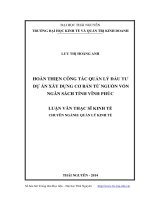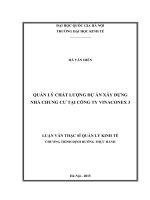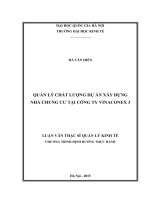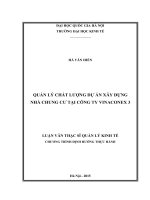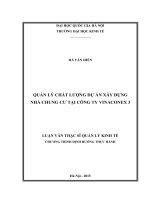quản lý Bim vào dự án xây dựng
Bạn đang xem bản rút gọn của tài liệu. Xem và tải ngay bản đầy đủ của tài liệu tại đây (1.82 MB, 70 trang )
Singapore BIM Guide
Version 2
BCA acknowledges the leadership provided by
the BIM Steering Committee in support of the
production of the Singapore BIM Guide.
The Singapore BIM Guide has been drafted by
the BIM Guide Workgroup on behalf of BCA and
the BIM Steering Committee.
©Building and Construction Authority 2013
Building and Construction Authority
5 Maxwell Road
#16-00 Tower Block MND Complex
Singapore 059110
www.bca.gov.sg
First published May 2012
2nd Version August 2013
While every effort has been made to ensure the
accuracy and quality of information contained
in this publication, the Building and
Construction Authority, its employees, agents
or industry partners can take no responsibility
for the subsequent use of this information, nor
for any errors or omissions that it may contain.
Cover image and design courtesy of RSP
Architects Planners & Engineers (Pte) Ltd and
the BCA Academy of the Built Environment.
Singapore BIM Guide Version 2
Contents
CEO’s Message ___________________________________________________________________ iii
BIM STEERING COMMITTEE ________________________________________________________ iv
BIM GUIDE WORKGROUP __________________________________________________________ vi
1
INTRODUCTION ______________________________________________________________ 1
BIM Deliverables _________________________________________________________________________ 1
BIM Processes (Modelling and Collaboration Procedures) ________________________________________ 1
BIM Professionals (BIM Manager and BIM Coordinator) __________________________________________ 2
2
BIM EXECUTION PLAN _________________________________________________________ 3
3
BIM DELIVERABLES ___________________________________________________________ 5
3.1
BIM Elements_______________________________________________________________________ 5
3.2
Attributes of BIM Elements ____________________________________________________________ 6
3.2.1
Model Progression _______________________________________________________________ 6
3.2.2
BIM vs 2D Practices ______________________________________________________________ 8
3.3
4.
BIM Objective & Responsibility Matrix __________________________________________________ 11
3.3.1
Model Author _________________________________________________________________ 12
3.3.2
Model Users ___________________________________________________________________ 12
3.4
Compensation Expectations __________________________________________________________ 13
3.5
Other Additional Value-added BIM Services _____________________________________________ 14
BIM Modelling and Collaboration Procedures______________________________________ 15
4.1
Individual Discipline Modelling ________________________________________________________ 16
4.1.1
Modelling Guidelines for BIM Elements _____________________________________________ 16
4.1.2
Modelling Guidelines for Regulatory Submission______________________________________ 16
4.1.3
Model Orientation ______________________________________________________________ 16
4.1.4
Model Division and Structure _____________________________________________________ 17
4.1.5
Revision Management ___________________________________________________________ 17
4.2
Cross-disciplinary Model Coordination __________________________________________________ 17
i
Singapore BIM Guide Version 2
4.2.1
4.3
Types of Model Coordination _____________________________________________________ 20
Model & Documentation Production ___________________________________________________ 21
4.3.1
Publishing 2D Drawings __________________________________________________________ 21
4.3.2
BIM Exchange Formats __________________________________________________________ 22
4.3.3
Documentation after Coordination_________________________________________________ 22
4.4
Data Security & Saving ______________________________________________________________ 22
4.5
Quality Assurance and Quality Control __________________________________________________ 23
4.6
Workflow of Design-Build Projects _____________________________________________________ 24
4.7
Workflow of Design-Bid-Build Projects __________________________________________________ 24
5
BIM Professionals ___________________________________________________________ 25
References _____________________________________________________________________ 27
Appendix A – Typical BIM Elements by Discipline _______________________________________ 28
(I)
Architectural BIM Elements __________________________________________________________ 28
(II)
Structural BIM Elements _____________________________________________________________ 29
(III)
Civil BIM Elements __________________________________________________________________ 30
(IV)
ACMV BIM Elements ________________________________________________________________ 31
(V)
Plumbing and Sanitary BIM Elements___________________________________________________ 32
(VI)
Fire Protection BIM Elements _________________________________________________________ 33
(VII) Electrical BIM Elements ______________________________________________________________ 33
(VIII) Gas BIM Elements __________________________________________________________________ 34
Appendix B – BIM Objective & Responsibility Matrix (Basic) ______________________________ 35
Appendix C – BIM Modelling Guidelines ______________________________________________ 41
(I)
Overview _________________________________________________________________________ 42
(II)
Quality Assurance __________________________________________________________________ 43
(III)
Architectural BIM Modelling Guidelines _________________________________________________ 44
(IV)
Structural BIM Modelling Guidelines ___________________________________________________ 48
(V)
MEP BIM Modelling Guidelines _______________________________________________________ 52
ii
Singapore BIM Guide Version 2
CEO’s Message
Dear readers,
Building Information Modelling (BIM) has gained much traction in recent
years as digital construction technology that will fundamentally transform
the building and construction industry practice in the delivery of an
excellent built environment. It is a game changing technology that will
improve the construction productivity as well as the level of
integration and collaboration across the various disciplines in the
construction value chain. It is therefore important for the
industry to embrace the technology with clarity.
The Singapore BIM Guide Version 2 is part of the industry’s efforts to demystify BIM and to
give clarity on the requirement of BIM usage at different stages of a project.
Under the leadership of the BIM Steering Committee chaired by Er Lee Chuan Seng, Emeritus
Chairman, Beca Carter, and comprising of leaders in BIM, the BIM Guide Workgroup has
contributed much time and effort to compile the various best practices to make this Guide
possible over a short span of time. We would like to thank them for their contribution.
We hope that every BIM user can truly reap the benefits of BIM by integrating it into his/her
day-to-day workflow – from feasibility study to facility management. We hope that BIM users
can use these guides as a platform to jumpstart their BIM adoption, before they leap to
greater heights, innovating and transforming their workflow.
BIM is a journey. We envisage that it will grow with time and will inspire more advanced and
innovative use of BIM. I would like to encourage all BIM practitioners to join in this industry
effort to grow this Guide into a wealth of BIM knowledge.
Dr John Keung
iii
Singapore BIM Guide Version 2
BIM STEERING COMMITTEE
The BIM Steering Committee (2011 - 2013) comprises of the following:
CHAIRMAN
ER LEE CHUAN SENG
Emeritus Chairman, Beca Asia Holdings Pte
Ltd
DEPUTY CHAIRMEN
ER LAM SIEW WAH
Deputy CEO (Industry Development),
Building and Construction Authority
ER LAI HUEN POH
Board Member, BCA; Managing Director,
RSP Architects Planners & Engineers (Pte)
Limited
INDUSTRY ASSOCIATIONS
ASSOCIATION OF CONSULTING
ENGINEERS SINGAPORE (ACES)
ER LIM PENG HONG
Imm. Past President; Managing Director, PH
Consulting Pte Ltd
ER LOH WAH KAY
Hon Treasurer; Principal Consultant, M & P
Consulting Engineers (S) Pte Ltd
BUILDINGSMART SINGAPORE
ER TEO KONG POON
President; Senior Director, Seagate
Technology International
INSTITUTE OF ENGINEERS SINGAPORE
(IES)
ER JOSEPH TOH
Council Member; Director, Beca Carter
Hollings & Ferner (SEA) Pte Ltd
ER CHAN EWE JIN
Representative; Managing Director, Ecas-Ej
Consultants Pte Ltd
REAL ESTATE DEVELOPERS’ ASSOCIATION
OF SINGAPORE (REDAS)
MR CHNG CHEE BEOW
Committee Member; Executive Director,
CEL Development Pte Ltd
MS QUEK CHAY HOON
Representative; Property Director, Wing Tai
Property Management Pte Ltd
MR TAI LEE SIANG
Representative; Group Managing Director,
Ong & Ong Pte Limited
SINGAPORE CONTRACTORS ASSOCIATION
LIMITED (SCAL)
MR DOMINIC CHOY
Secretary-General; GM (Projects), Hexacon
Construction Pte Limited
SINGAPORE INSTITUTE OF SURVEYORS
AND VALUERS (SISV)
PROF TOR YAM KHOON
Div 2nd VP (LS); Associate Professorial
Fellow, Nanyang Technological University
MR WONG KEAM TONG
Representative; Senior Technical Manager,
Woh Hup (Pte) Ltd
MS LOH SUAT YEN
Div Representative (LS); Principal Land
Surveyor, Housing & Development Board
MR YAP HONG KENG
Representative; BIM Manager, Hexacon
Construction Pte Limited
MR KHOO SZE BOON
Div 1st VP (QS); Executive Director, Langdon
& Seah Singapore Pte Limited
SINGAPORE INSTITUTE OF ARCHITECTS
(SIA)
MR WILLIAM LAU
1st VP; Principal, William Lau Architects
MR GOH NGAN HONG
Div 2nd VP (QS); Senior Consultant, CPG
Consultants Pte Limited
MR BEN THUM
Representative; Innovation Director,
SIACAD Pte Limited
MR LOH JU-HON
Council Member; Director, RDC Architects
Pte Ltd
iv
MR EUGENE SEAH
Div Hon Treasurer (QS); Deputy Chairman,
Langdon & Seah Singapore Pte Limited
MS EVELYN CHANG
Executive Director
Singapore BIM Guide Version 2
GOVERNMENT PROCUREMENT ENTITIES
HOUSING & DEVELOPMENT BOARD
(HDB)
MR SNG CHENG KEH
Deputy CEO (Building)
MR THOMAS SEOW
Group Director
MR LARRY CHENG
Director / Sr Principal Architect, HDB
Building Research Institute
MR MUHAMMED FIRDAUS MAYATIM
Engineer
ER NEO BIAN HONG
Deputy Group Director
MDM WU FENG CHU
Senior Manager
SINGAPORE LAND AUTHORITY (SLA)
DR VICTOR KHOO
Deputy Director (Land Survey)
MR DERICK TAN
Principal Surveyor (Land Survey)
MINISTRY OF EDUCATION (MOE)
MR ENG WEE TONG
Deputy Director
MR SOON KEAN HUAT
Senior Surveyor (Land Survey)
MR TAN CHEE CHUEN
Senior Head
MS CARMEN HONG
Senior Head
LAND TRANSPORT AUTHORITY (LTA)
ER PAUL FOK
Group Director / Chief Engineer
REGULATORY AGENCIES
BUILDING AND CONSTRUCTION
AUTHORITY (BCA)
ER CHEW KEAT CHUAN
Group Director
FIRE SAFETY AND SHELTER DEPARTMENT
(FSSD)
MR BOO GEOK KWANG
Director
URBAN REDEVELOPMENT AUTHORITY
(URA)
MR PETER TAN
Senior Director
ER THANABAL KALIANNAN
Director
MR LEE WEE KEONG
Assistant Director
MR LOH TECK HEE
Director
MR CHENG TAI FATT
Deputy Managing Director, BCA Academy
of the Built Environment
MR HENG CHAI LIANG
Assistant Director
MR CHIN KOON FUN
Principal Planner
ER TAN LING LING
AECOM SINGAPORE PTE LTD
CONSTRUCTION INDUSTRY IT
STANDARDS TECHNICAL COMMITTEE
(CITC)
MR EDWARD D'SILVA
Chairman
DR TAN KEE WEE
Director, Centre of Construction IT
OTHERS
BIM MANAGERS FORUM
MR JOSEPH SIM
Shimizu Corporation Singapore
ER LIEW VE KOON
P&T Consultants Pte Ltd
MR DANIELS CHANDRA
Ong & Ong Pte Ltd
MS ANG KOOI FUNG
Woh Hup (Pte) Ltd
MR WONG HAO JAN
DP Architects Pte Ltd
LEGAL & CONTRACTUAL WORKGROUP
MR PAUL WONG
Chairman; Partner, Rodyk & Davidson LLP
MR ASHWIN MURARI
3PA International
v
Singapore BIM Guide Version 2
BIM GUIDE WORKGROUP
The BIM Guide Workgroup comprises of the following:
CO - CHAIRMEN
MR CHNG CHEE BEOW
Committee Member; Executive Director,
CEL Development Pte Ltd
MR LARRY CHENG
Director / Sr Principal Architect, HDB
Building Research Institute
MEMBERS
MR LAWRENCE LEONG
Manager, City Developments Limited
MR LAWRENCE LEONG
Manager, City Developments Limited
MS TAY SEOK CHENG
Senior Manager, City Developments Limited
MS NINA TEO
IT Manager, CapitaLand
MR LEE YEW KWUNG
Senior VP, CapitaLand Residential
Singapore Pte Limited
MR MARK TUNG
Senior Manager, Land Transport Authority
MR GOH KOK WEE
Project Manager, CapitaLand Residential
Singapore Pte Limited
MDM CARMEN HONG
Infrastructure Executive, Ministry of
Education
MR ASOKAN S/O TK
Senior Manager, Defence Science and
Technology Agency
MS GERMAINE CHUNG
Senior Head, Ministry of Education
RESOURCE PERSONS
ARCHITECTURE
CIVIL & STRUCTURAL ENGINEERING
MS GRACE LIM
Senior CAD / BIM Manager, AEDAS Pte
Limited
ER LAUW SU WEE
Managing Director, LSW Consulting
Engineers Pte Limited
MR VINCENT KOO
Managing Director, DCA Architects Pte
Limited
MR TEE KOK KUANG
IT Administrator, LSW Consulting Engineers
Pte Limited
MR HOO CHUEN PIEW
Director, DP Architects Pte Limited
MR PHIL LAZARUS
Senior BIM Specialist, Arup Singapore Pte
Limited
MR DANIELS CHANDRA
Director, BIM, Ong & Ong Pte Limited
MDM VIVIEN HENG
Director, RSP Architects Planners &
Engineers (Pte) Limited
MR KESARI PAYNENI
BIM Manager, RSP Architects Planners &
Engineers (Pte) Limited
MECHANICAL & ELECTRICAL
ENGINEERING
ER BRYAN CHIN
Senior Associate Director, Beca
ER TIMMY MOK
Senior Principal, T. Y. Lin International Pte
Limited
vi
ER LEONG CHENG WEE
Director, Method Engineering Pte Limited
MS SUM YUIT MEI
Planning Manager, Squire Mech Pte Limited
QUANTITY SURVEYING
MR SILAS LOH
Partner, Rider Levett Bucknall LLP
MS EUGENIE LIP
Director, KPK Quantity Surveyors
(Singapore) Pte Limited
CONTRACTORS
MR EDMUND LEONG
BIM Manager, Tiong Seng Contractors Pte
Limited
Singapore BIM Guide Version 2
MS ANG KOOI FUNG
BIM Manager, Woh Hup (Pte) Limited
INTERDISCIPLINARY
MR STEVEN TAN
Senior IT Associate, BIM Specialist,
Manager, CPG Corp Pte Limited
GOVERNMENT PROCUREMENT ENTITIES
ER TANG PEI LUEN
Senior Principal Engineer, JTC Corporation
MS CHERLYN LEONG
Principal Engineer, JTC Corporation
MR MARK TUNG
Senior Engineer, Land Transport Authority
INDUSTRY ASSOCIATIONS
ER JOSEPH TOH
Council Member; Director, Beca Carter
Hollings & Ferner (SEA) Pte Ltd
MR DOMINIC CHOY
Secretary-General; GM (Projects), Hexacon
Construction Pte Limited
MR KUAN CHEE YUNG
Council Member, Singapore Institute of
Architects; Senior Vice President
(Architecture), CPG Consultants Pte Limited
MR DARREN BENGER
Council Member, Singapore Institute of
Architects; Director, ATA Architects Pte
Limited
vii
CENTRE FOR CONSTRUCTION IT,
BUILDING & CONSTRUCTION AUTHORITY
MR JUSUF ANGGONO
MR CHIDAMBARAM
MR FELIX BATAD
MR SONNY ANDALIS
MS HUANG YIXIANG
MR LIU ZIWEN
Singapore BIM Guide Version 2
1
INTRODUCTION
The Singapore BIM Guide Version 2 aims to outline the various possible deliverables,
processes and personnel / professionals involved when Building Information Modelling (BIM)
is being used in a construction project.
Users can use the Guide to clarify the roles and responsibilities of project members when
using BIM in a construction project. The roles and responsibilities are then captured in a BIM
Execution Plan, to be agreed between the Employer and project members.
BIM DELIVERABLES
This chapter specifies the “what” to be produced by the respective project
member(s) at different stages of a project to meet a set of BIM objectives. All the
agreed deliverables are indicated in the “BIM Objective and Responsibility Matrix”.
Each deliverable usually consists of a set of BIM model elements (or elements). Each
element is usually a digital representation of the physical and functional
characteristics of an actual building component to be used in the project.
Each element usually consists of a set of geometric representations and nongeometric attributes, which can be increased in details as the project progresses.
This guide also attempts to address the additional effort likely to be expended
upfront to build up an information-rich BIM model or to perform other BIM valueadded services for the project.
BIM PROCESSES (MODELLING AND COLLABORATION PROCEDURES)
This chapter defines the “how” and the steps taken to create and share the BIM
deliverables at different stages of the project.
1
Singapore BIM Guide Version 2
A set of possible modelling guidelines is provided in this Guide to guide the project
members in creating the BIM deliverables at different stages of the project.
A set of possible collaboration procedures is also provided in this Guide to assist the
project members in sharing the BIM deliverables with other project members at
different stages of the project.
BIM PROFESSIONALS (BIM MANAGER AND BIM COORDINATOR)
This chapter outlines the “who” – typical new professionals known as the BIM
manager and BIM coordinator. They are responsible for the definition, management
and completion of the BIM Execution Plan.
The use of BIM can be incorporated into the project as part of the scope of services under the
Principal Agreement with the help of the BIM Particular Conditions Version 2.
2
Singapore BIM Guide Version 2
2
BIM EXECUTION PLAN
To effectively introduce BIM into the project delivery process, it is important for the project
team to develop a BIM Execution Plan at the early stages of a project. It outlines the overall
vision and along with implementation details for the project team to follow throughout the
project. It is usually defined at the start of the project and when new project members have
been appointed, to accommodate their participation.
A BIM Execution Plan helps the Employer and project members to document the agreed BIM
deliverables and processes for the project. The Principal Agreement can make reference to the
BIM Execution Plan to define the roles and responsibilities of the project members for their
BIM deliverables.
By developing a BIM Execution Plan, the Employer and project members can:
Clearly understand the strategic goals for implementing BIM on the project;
Understand their roles and responsibilities for Model creation, maintenance and
collaboration at different stages of the project;
Design a suitable process for them to participate in the implementation;
Outline additional resources and services that may be needed; and
Provide a baseline plan to measure progress throughout the project
The content of a BIM Execution Plan includes the following:
Project information;
BIM goal & uses;
Each project member’s roles, staffing and competency;
BIM process and strategy;
BIM exchange protocol and submittal format;
BIM data requirement;
Collaboration procedures and method to handle shared Models;
Quality control; and
Technology infrastructure & software
3
Singapore BIM Guide Version 2
The BIM Execution Plan can be appended with additional information to facilitate additional
members to join the project at later stages. Updates to the BIM Execution Plan should be
made with the permission of the Employer or his appointed BIM Manager and should not go
against conditions of the Principal Agreement.
For more information on the BIM Execution Plan, please refer to the BIM Essential Guide For
BIM Execution Plan, which also includes a BIM Execution Plan template.
4
Singapore BIM Guide Version 2
3
BIM DELIVERABLES
This chapter defines “what” – the BIM deliverables” to be produced by the respective project
member(s) at different stages of a project to meet a set of BIM objectives. All the agreed
deliverables are indicated in the “BIM Objective and Responsibility Matrix”.
BIM project deliverables should be agreed upon together with deliverable dates at the start of
the project and after the main project members have been appointed so as to accommodate
their participations. Some of the typical deliverables are shown below:
3.1
Site model
Massing model
Architectural, structural, MEP models
o For regulatory submissions
o For coordination and / or clash detection analysis
o For visualization
o For cost estimation
Schedule (material, time etc) and phasing program (in BIM or spreadsheet)
Construction and fabrication models
Shopdrawings
As-built model (in native proprietary or open formats)
Data for facility management
Other additional value-added BIM services
BIM ELEMENTS
Each deliverable usually consists of a set of BIM model elements (or elements). Each element
is usually a digital representation of the physical and functional characteristics of an actual
building component to be used in the project. A typical set of BIM elements for a project can
be found in Appendix A, categorized according to discipline.
5
Singapore BIM Guide Version 2
3.2
ATTRIBUTES OF BIM ELEMENTS
An important aspect of BIM is the ability to contain information in the model. This information
can come in geometric and non-geometric forms.
Table 1: Examples of Geometric and Non-Geometric Attributes of BIM Elements
GEOMETRICAL ATTRIBUTES
NON-GEOMETRICAL ATTRIBUTES
Size
System data
Volume
Performance data
Shape
Regulatory compliance
Height
Specifications
Orientation
Cost
Examples
There are a number of national and international efforts attempting to define and standardise
the attributes for each BIM element. It is recommended that attributes of a BIM element be
determined to meet their intended usage so as to avoid over specifying. References include:
VA Object/Element Matrix www.cfm.va.gov/til/bim/BIMGuide/downloads/oemf.xls
Level of Development (LOD) Specification bimforum.org/lod/
3.2.1
Model Progression
The attributes of a BIM element can change/increase in details as the project progresses. For
example, the piling BIM element on the following page shows how its geometric information
changes throughout a project, and how this information is represented.
6
Singapore BIM Guide Version 2
PROJECT STAGES
DETAILS OF BIM
At early design stage, piling
may not be modelled due to
lack of information
At the detailed design stage,
the piling details have been
developed from structural
analysis and design.
The pile cap and piles are
also accurately modelled
and located in the BIM
model.
2D details such as rebars
can be used to complement
the BIM model
During the construction
stage, more detailed
information is modelled for
the piling. Rebars can also
be represented in the model
in 3D.
It is also acceptable to
represent the details in 2D
shopdrawings
7
Singapore BIM Guide Version 2
3.2.2
BIM vs 2D Practices
It is essential for local BIM users to relate the BIM deliverables to the current 2D practices.
One such example is shown in Table 2.
Table 2: Example of BIM deliverables at different stages
2D
PROJECT STAGES
MILESTONES
Conceptual
Design
Outline
Planning
Permission
Project
Feasibility
Schematic /
Preliminary
Design
Planning
Approval
Design & Build
Tender
Documentatio
n
DRAWING
SCALES
1:200 to
1:1000
1:200
GENERAL LEVEL OF DETAIL OF EACH BIM MODEL
ELEMENT / ASSEMBLY
Building massing studies or other forms of data
representation with indicative dimensions, area,
volume, location and orientation
BIM deliverable: massing model (Source: HDB)
Generalized building component or system with
approximate dimensions, shape, location, orientation,
and quantity. May include non-geometric properties.
BIM deliverable: preliminary design model
(Source: HDB)
8
Singapore BIM Guide Version 2
2D
PROJECT STAGES
MILESTONES
Detailed Design
Building Plan
Approval
Continued
Design & Build
Tender
Documentatio
n or
Design-BidBuild Tender
Documentatio
n
Construction
Constructabilit
y
Fabrication
DRAWING
SCALES
1:200
1:5 –
1:100
GENERAL LEVEL OF DETAIL OF EACH BIM MODEL
ELEMENT / ASSEMBLY
More detailed version of a generalized building
component or system with accurate dimensions, shape,
location, orientation, and quantity. Non-geometric
properties should be provided.
BIM deliverables (from left): detailed design model,
BIM-generated detailed drawings (Source: HDB)
BIM element is modelled with complete fabrication and
assembly details over and above the Detailed Design
stage where applicable or useful for construction works;
otherwise, details may be represented in 2D CAD
drawings to complement the Detailed Design stage level
of detail.
BIM deliverable: Steel Framing model
(Source: Hexacon Construction Pte Ltd)
9
Singapore BIM Guide Version 2
2D
PROJECT STAGES
MILESTONES
As-Built
TOP / CSC
Final
Facility
Management
O&M
DRAWING
SCALES
1:100
1:50
GENERAL LEVEL OF DETAIL OF EACH BIM MODEL
ELEMENT / ASSEMBLY
BIM element is similar in level of detail to the Detailed
Design stage, but updated with changes during the
Construction stage.
Comparing the as-built structural model (BIM
deliverable, left) with actual site (right)
(Source: Hexacon Construction Pte Ltd)
BIM element is modelled as an actual constructed
building component or system and is an as-built
representation of the actual completed building.
Water storage tank element with attached
specification PDF (Source: HDB)
10
Singapore BIM Guide Version 2
3.3
BIM OBJECTIVE & RESPONSIBILITY MATRIX
The BIM Objective and Responsibility Matrix indicates the basic BIM deliverables (1) required
to meet each BIM Project Objective (2). A BIM Project Objective also refers to the use of BIM
in a particular stage of the project. It also shows which project members (3) are involved in
each objective. Columns can be increased or reduced, depending on the number of users (by
discipline) involved in the BIM process of the project (4). The last step of defining the matrix is
to indicate whether the selected project member is a model author or model user for each
deliverable. (5) A matrix template can be found in Appendix B.
2
3
Project members involved in
fulfilling the objective
A – model author; U – model users
Arch Struc MEP PM Contractor
BIM Project Objective
Name of building stage: ______________________________________
General description of BIM in this building stage:
__________________________________________________________
Example:
Detailed Design
More detailed version of a generalized building component or system
with accurate dimensions, shape, location, orientation and quantity.
Non-geometric properties should be provided.
BIM Project Objective: _______________________________________
5
BIM deliverable(s) to be achieved through this objective:
__________________________________________________________
Example:
13. Maintain and update the Structural Model, based on the latest
Architectural Model
Design, analysis and detailing
In preparation for regulatory submission
In preparation for tender
1
Suggested Deliverable
Structural Model and Calculation
11
U
A
U
U
FOR
REFER
-ENCE
ONLY
4
Singapore BIM Guide Version 2
3.3.1 Model Author
The model author is a party responsible for the creation and maintenance of a specific model
to the level of detail prescribed in the BIM Project Objectives & Responsibility Matrix. In
creating and maintaining the model, the model author does not convey any ownership right of
the model. Any subsequent model author’s or model user’s right to use, modify and transmit
the model is specifically limited to the scope of the project. The Employer may specify for
ownership of the model in the Principal Agreement. Before providing the model to model
users, it is recommended that the model author should perform quality control checks of their
models (Refer to Chapter 4.5, page 23)
3.3.2 Model Users
Model users are parties authorised to use the model on the project. The model can be
provided in native or neutral (such as IFC) format for the model users’ reference and use
related to the project. Although model authors have checked the accuracy and quality of the
model before sharing with model users, model users should use the model for reference only,
and should also check, verify and otherwise confirm the accuracy of the model. Where
inconsistency is found in the model, the model user shall promptly notify the model author for
clarification. The model users shall make no claim against the author in connection with the
use of the model. The model users shall also indemnify and defend the model author against
all claims from or related to subsequent use or modification by the model users.
12
Singapore BIM Guide Version 2
3.4
COMPENSATION EXPECTATIONS
In general, additional upfront preparation is required for one to use BIM effectively and to
build up an information rich BIM model as compared with the current use of 2D for design and
construction. This upfront work starts with design consultants working on the BIM model at
various design stages, as well as with builders who build a construction model from 2D
drawing or design BIM model. It is essential to recognise this upfront effort by all the parties.
The Singapore BIM Steering Committee, recognizing that BIM adoption increases efforts at the
design stages, recommends a 5% shift in percentage-based consultancy fee payment, from the
Construction to Design stages, as illustrated in Table 4. However, this upstream shift of effort
does not necessarily result in increased in the consultancy fees.
Table 4: Example of a Payment Schedule in a BIM Project
% change from
non-BIM to BIM payment
Project Stage
Preliminary Design
Planning Approval
Design Development
Tender and Award
DESIGN STAGES *
Construction Administration
Post construction
CONSTRUCTION STAGES*
Percentage change in total fees
+2.5
0
+2.5
0
+5
-5
0
-5
0
* refers to cumulative percentage fees
When releasing design BIM from designers to builders, there may be some cost implications.
The Singapore BIM Steering Committee also recommends that this cost should be made
known to all builders at the tender stage.
13
Singapore BIM Guide Version 2
3.5
OTHER ADDITIONAL VALUE-ADDED BIM SERVICES
With BIM, digital analysis may be performed to better understand the performance of the
building. These analyses should be considered as additional services. Examples of such
services may include the following:
Environmental simulation and analysis (for Concept Design Purpose only)
Energy validation to estimate energy usage requirements
Lighting design validation & visualization
4D construction scheduling and sequencing (applicable for Design & Build projects)
Green Mark, RETV, Buildability and Constructability Scores based on BIM model(s)
BIM model of existing building(s) for master plan site study and feasibility analysis
(A&A)
Providing Structural and MEP system alternatives based on conceptual massing
models
Project cost estimates based on conceptual massing models
MEP cost estimates based on MEP BIM model
The Employer should understand the potential cost implication for asking such value-added
BIM services. It is recommended that additional fees are negotiated among the parties
involved.
Furthermore, if BIM services required in the BIM Objective & Responsibility Matrix are agreed
to be necessary at an earlier project stage than indicated, these services could also be
recognized as additional effort from respective Model Authors. This is because less data is
available at an earlier project stage, thus the authors may require additional effort to be able
to perform the BIM service.
14
Singapore BIM Guide Version 2
4.
BIM Modelling and Collaboration Procedures
This chapter defines “how” BIM is to be created and shared throughout the project.
A typical BIM process involves model creation (1), model coordination and data exchange (2)
involving a team of model authors and users. Upon resolution of identified issues (e.g.
coordination clashes) during each project milestone, a version of model can then be frozen
and released to the model users (3).
(1)
Model Creation by Respective Model Authors (see chapter 3.1)
Discipline 1
Discipline 2
Discipline n
Quality Checks
(2)
Model Coordination Involving Model Authors and Users
(see chapter 3.2)
Discipline 2
Model 2
coordination
Discipline 1
Model 1
Model n
Discipline n
Authorised by BIM Manager
(3)
Models are Frozen and Released (see chapter 3.3)
Co-ordinated and validated models can be released for use by model users.
The models are also frozen as part of project history
15
Singapore BIM Guide Version 2
4.1
INDIVIDUAL DISCIPLINE MODELLING
At this stage each model author will create his model according to the agreed deliverables as
stated in the BIM Execution Plan. The model is stored in and worked on, by the modelling
team of each author and has not yet been checked and verified for use outside of the team.
To ensure modelling quality, Model Authors should set up and follow a minimum standard of
modelling requirements during BIM project implementation.
4.1.1 Modelling Guidelines for BIM Elements
A set of modelling guidelines for key BIM elements at different stages of a project can be
found in Appendix C of this document. The modelling guidelines are grouped by Architectural,
Structural and MEP disciplines in this version of the document.
In general, each element will be modelled according to its size, shape, location, orientation
and quantity. At the early stages of the project, element properties are more generic and
approximate, but become more specific and increases in accuracy as the project progresses.
4.1.2 Modelling Guidelines for Regulatory Submission
Architectural, Structural and MEP modelling guidelines and templates for Singapore BIM esubmissions for regulatory purpose can be found at
/>
4.1.3 Model Orientation
The origin point of the project should be clearly defined and drawn in the SVY21 coordinate
system and with reference to the SLA Vertical Control Point (VCP) plus 100m.
16





